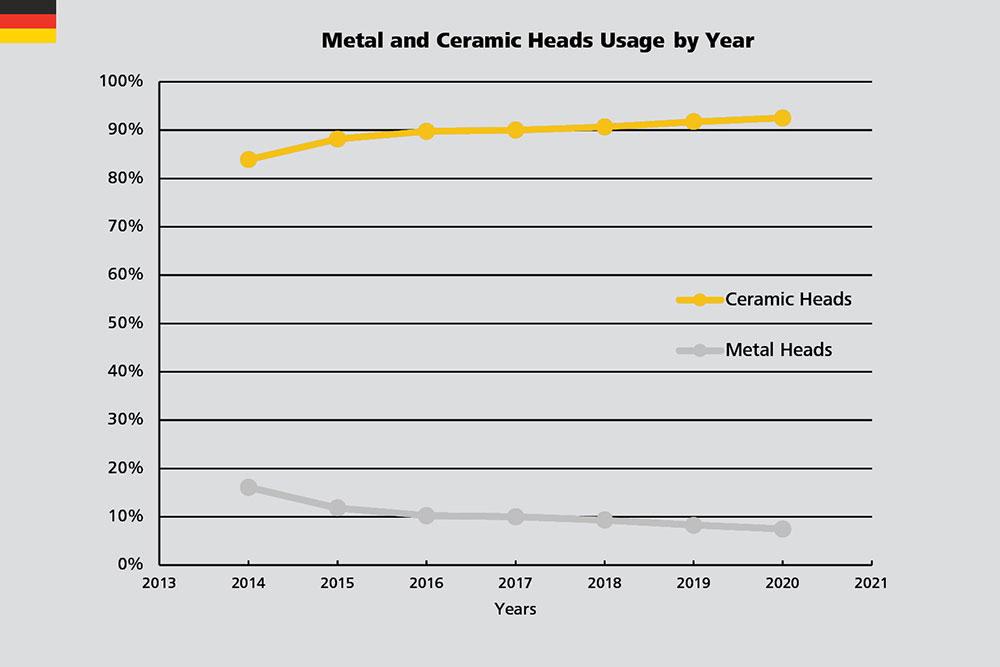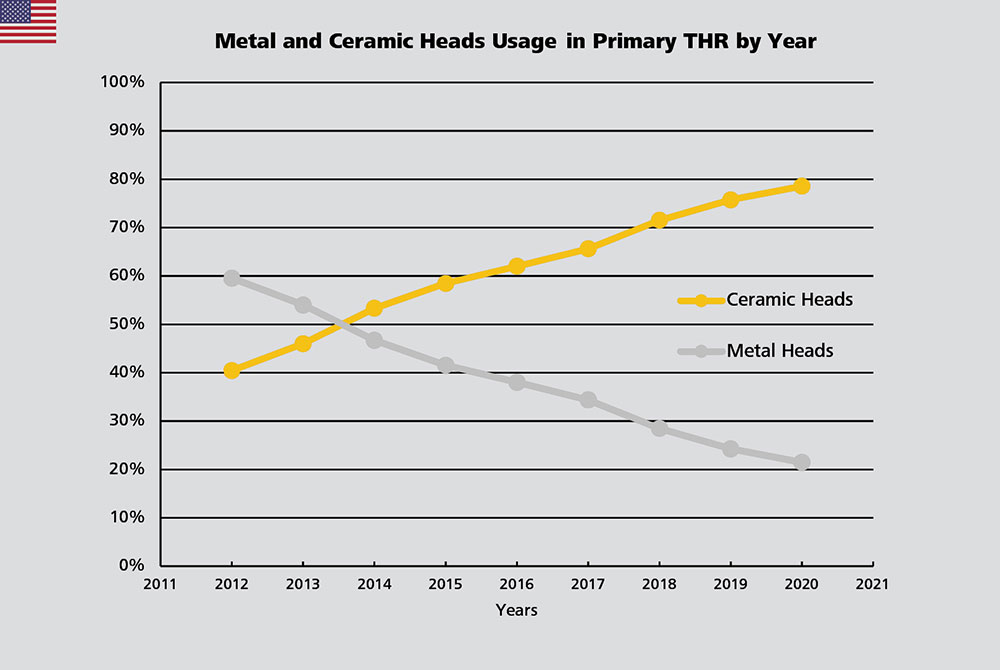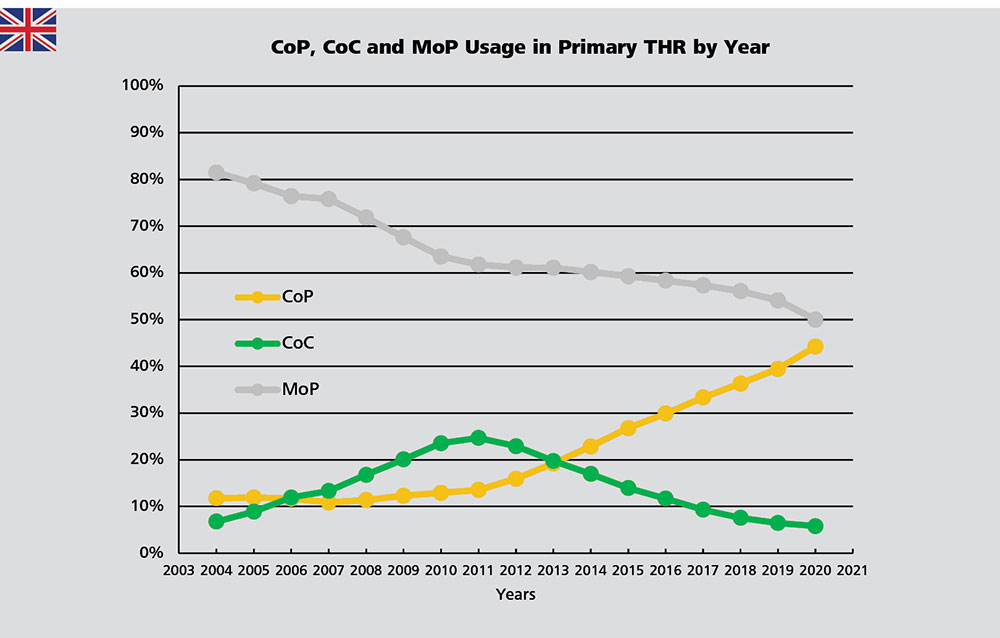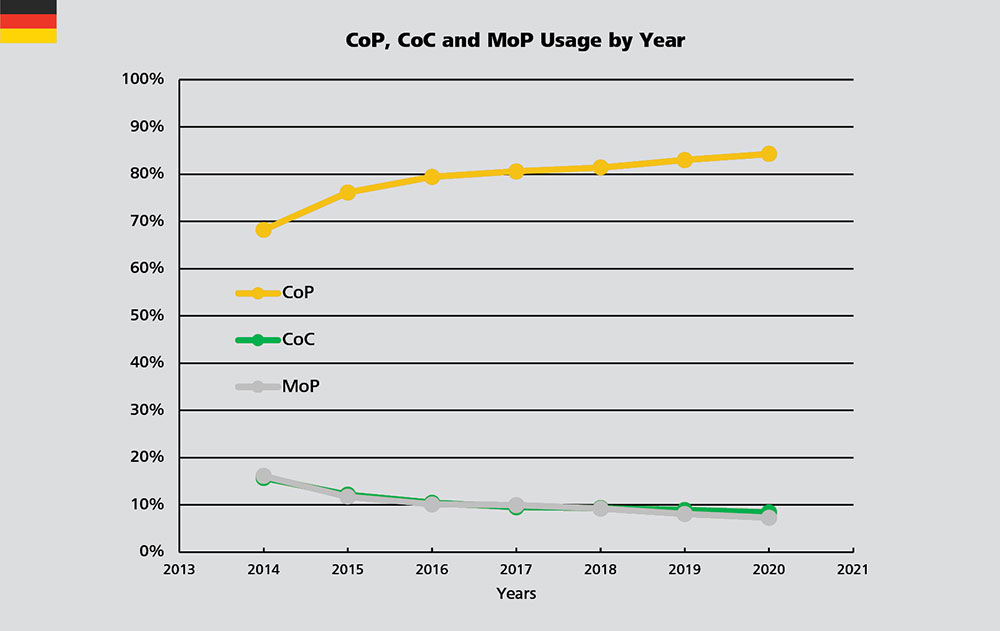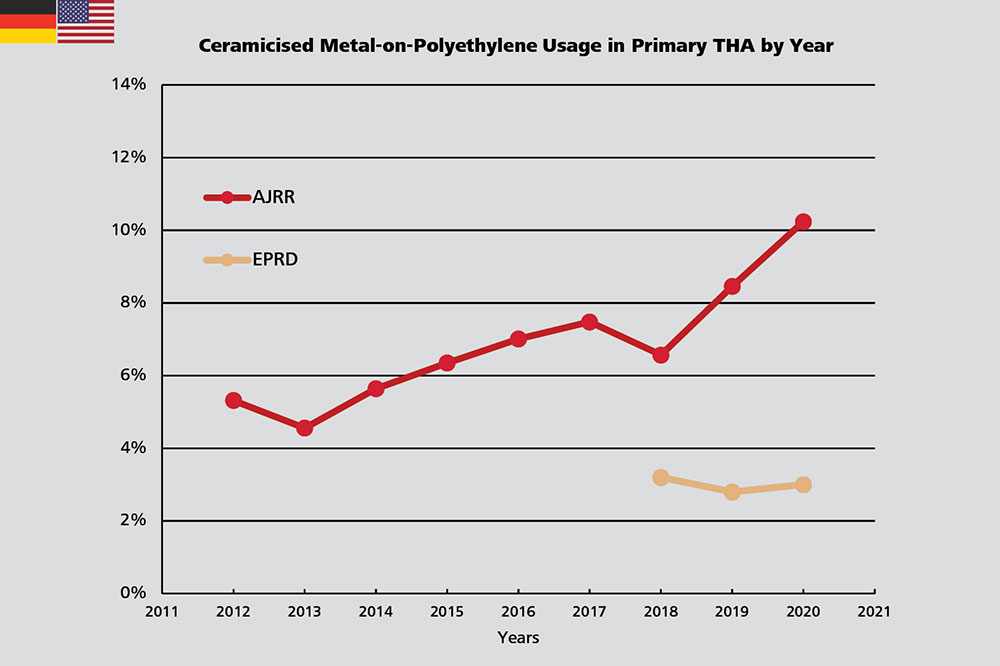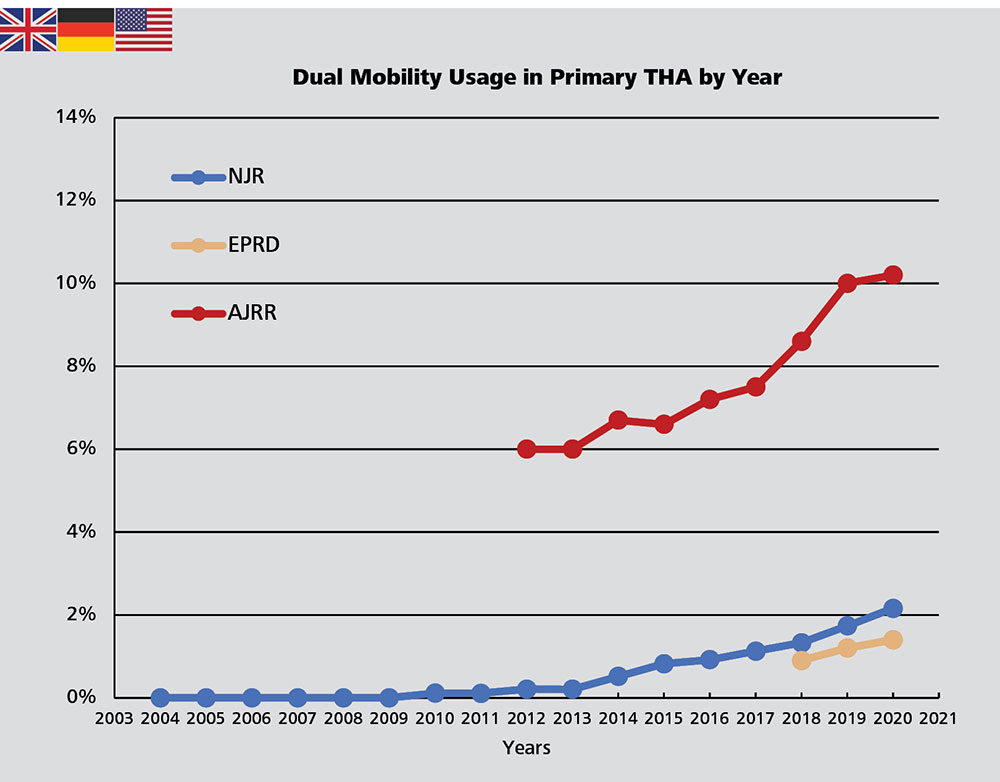Fixation and Bearings in Hip Replacement
Despite some distinct differences among countries, there is a continuing overall trend toward uncemented and especially hybrid fixation at the expense of the all-cemented procedures. Larger head sizes and dual mobility constructs are also gaining in popularity. Ceramic femoral heads more and more supplant metal femoral heads.
The following overview is based on the 2021 Annual Reports of the registries of Australia, Germany, New Zealand, Sweden, the USA as well as registry for England, Wales, Northern Ireland, the Isle of Man and the States of Guernsey.
Overview:
- THR Fixation: More Hybrid, Less Cement
- Bearing Size and Material Distribution: A Trend Towards Larger Head Sizes
- Distribution of Ceramic and Metal Heads in THA: Hip Procedures with Ceramic Heads are not an Alternative Anymore
- Bearing Surfaces: Ceramic-on-Polyethylene the Preferred Option
- Ceramicised Metal-on-Polyethylene: Adoption in Different Countries
- Dual Mobility Constructs: Growing Usage in Primary and Revision THR
There is a continuing trend in favor of uncemented fixation in Australia, making up for 60.8% in 2020 vs. 51.3% in 2003. The percentage of hybrid fixation rose slightly from 34.8% in 2003 to 36.8% in 2020, while the numbers for cemented fixation decreased significantly, from 13.9% in 2003 to 2.4% in 2020.2
Fully cemented fixation has continuously decreased in Sweden since 2000 and accounts for 50% of all procedures in all age groups in 2020. In the group of patients age below 65, the uncemented fixation has become the preferred option. The majority of the patients under 54 undergoes THA with uncemented fixation. The proportion of reversed hybrids has decreased since 2012 and the SAR reports an increase of hybrid fixation since 2010 from about 1.5% to 7.1% in 2020.6
Figure 1a (left): Distribution of fixation methods in primary hip replacement in 2020: in Australia, Germany, as well as England, Wales, Northern Ireland, the Isle of Man and the States of Guernsey.
Figure 1b (right): Distribution of femoral stem fixation methods in primary hip replacement in 2020 in the USA.
Evaluation of the data by CeramTec based on NJR Annual Report 2021 Page 51 Table 3.H21, AOA NJRR Annual Report 2021 Page 83 Figure HT32, EPRD Annual Report 2021 Page 19 Table 53, and AJRR Annual Report 2021 Page 41 Figure 2.254.
Bearing Size and Material Distribution: A Trend Towards Larger Head Sizes
There is a trend towards 32mm femoral heads according to the considered European registries and NZJR, whereas the AOA NJRR and AJRR report a larger usage of the 36mm bearings.
The NJR and AOA NJRR Annual Reports 2021 provide information on the size as well as the material of femoral heads used in THR allowing for analysis of the combinations. It should be mentioned that the AOA NJRR only considers procedures involving mixed ceramic bearings as of 2017 for the primary THA analysis. The intention behind is to deliver an analysis reflecting the modern surgical praxis.
The Australian registry distinctly looks at the usage of “mixed ceramic” components like BIOLOX®delta in THR. 36-38mm mixed ceramic/mixed ceramic bearings accounted for 73.8% of all primary THR procedures with this bearing surface in patients diagnosed for osteoarthritis in the period 2003-2020.2
Figure 2a (left): Cumulative head size distribution of ceramic bearings in England, Wales, Northern Ireland, the Isle of Man and the States of Guernsey.
Figure 2b (right): Cumulative head size distribution of mixed ceramic/mixed ceramic bearings in Australia.
Evaluation of the data by CeramTec based on the NJR Annual Report 2021 Page 79 Figure 3 H10 (b, e, f, h, I, k)1, and the AOA NJRR Annual Report 2021 Page 128 Table HT332.
Figure 3: Percentage of metal and ceramic femoral heads in primary THR by year in England, Wales, Northern Ireland, the Isle of Man and the States of Guernsey.
Evaluation of the data by CeramTec based on NJR Annual Report 2021 Page 51 Table 3.H21. Only the hip procedures with ceramic and metal heads have been included in the analysis.1
Figure 4: Percentage of ceramic and metal femoral heads by year in Germany.
Evaluation of the data by CeramTec based on EPRD Annual Reports 2014 to 2021 (For operation year 2014, the number indicates percentage of all primary hip replacements. For operation years 2015 to 2020, the numbers indicate percentage of all primary THR)3, 13-18. Only the hip procedures with ceramic and metal heads have been included in the analysis.
In Australia, almost the totality, 96.8%, of the bearings implanted in 2020 consisted of mixed ceramic- and metal-on-cross-linked polyethylene, and mixed ceramic-on-mixed ceramic. The latter is defined as "modern bearing surfaces" by the registry. The hard-on-soft bearings with a ceramic head account for approximately half of the bearing surfaces implanted. CoC with mixed ceramic consisted of 99.7% of all primary total conventional hip procedures. When polyethylene was used, in 97.3% of the procedures in 2020, was XLPE. The usage of metal heads and CoC is gradually decreasing.2,7-12
Figure 6: Usage of CoP, CoC and MoP bearings in primary THA by year in England, Wales, Northern Ireland, the Isle of Man and the States of Guernsey.
Evaluation of the data by CeramTec based on the NJR Annual Report 2021 Page 51 Table 3.H21. Only the hip procedures with CoP, CoC and MoP have been included in the analysis.
Figure 7: Usage of CoP, CoC and MoP by year in Germany.
Evaluation of the data by CeramTec based on the EPRD Annual Reports 2014 to 2021. For the operation year 2014, the number indicates percentage of all primary hip replacements; for operation years 2015 to 2020, the numbers indicate percentage of all primary THRs3, 13-18. Only the hip procedures with CoP, CoC and MoP have been included in the analysis.
Ceramicised Metal-on-Polyethylene: Adoption in Different Countries
In the USA, the use of CMoP has nearly doubled between 2012 and 2020 from 5.3% to 10.2%.4 No significant change was recorded in Germany where approximately 3% of primary THRs are performed with CMoP femoral heads since 2018.3,17,18 The NZJR5, the SAR6 and the NJR1 do not include CMoP bearings in their annual reports. However, a study analyzing the British dataset shows that 9,237 CMoP bearings with an uncemented acetabular component were used between January 1, 2004, and July 28, 2016.19
Before 2013, dual mobility was scarcely used. An increase from less than 0.1% in 2004 to 2.2% of all primary THR in 2020 can be observed, of which nearly one-third is performed with a ceramic head (CoPoM: 28.6%, MoPoM: 71.4%). Dual mobility bearings are mostly used in cases of fractured femoral neck, accounting for 8.4% of these cases in 2020.1
In the United States, the use of dual mobility in both primary and revision hip replacement has continued to increase and accounted for 10.5% of all bearings used in elective primary surgeries in 2020, up from 5.32% in 2012. Dual mobility was used in over 25% of all revision procedures in 2020. This type of construct is used in all patient age groups: 9.4% of the patients under 50 years received a dual mobility bearing.4
1. National Joint Registry. 18th Annual Report 2021 Surgical data to 31 December 2020. ISSN 2054-183X (Online) 2021: 1-376.
2. Australian Orthopaedic Association National Joint Replacement Registry (AOANJRR). Hip, Knee & Shoulder Arthroplasty: 2021 Annual Report, Adelaide; AOA, 2021: 1-432. [Accessed from: aoanjrr.sahmri.com/annual-reports-2021].
3. Endoprothesenregister Deutschland (EPRD). Jahresbericht 2021 Mit Sicherheit mehr Qualität. ISBN: 978-3-9817673- 9-1 2021: 1-193.
4. American Joint Replacement Registry (AJRR): 2021 Annual Report. Rosemont, IL: American Academy of Orthopaedic Surgeons (AAOS), 2021.
5. The New Zealand Joint Registry. Twenty-two year report January 1999 to December 2020. 2021: 1-196.
6. The Swedish Arthroplasty Register. Annual report 2021. ISSN 1654-5982. 2021: 1-224.
7. Australian Orthopaedic Association National Joint Replacement Registry. Annual Report. Adelaide: AOA; 2015.
8. Australian Orthopaedic Association National Joint Replacement Registry. Annual Report. Adelaide: AOA; 2016.
9. Australian Orthopaedic Association National Joint Replacement Registry (AOANJRR). Hip, Knee & Shoulder Arthroplasty: 2017 Annual Report. Adelaide: AOA, 2017.
10. Australian Orthopaedic Association National Joint Replacement Registry (AOANJRR). Hip, Knee & Shoulder Arthroplasty: 2018 Annual Report. Adelaide: AOA, 2018.
11. Australian Orthopaedic Association National Joint Replacement Registry (AOANJRR). Hip, Knee & Shoulder Arthroplasty: 2019 Annual Report. Adelaide: AOA, 2019.
12. Australian Orthopaedic Association National Joint Replacement Registry (AOANJRR). Hip, Knee & Shoulder Arthroplasty: 2020 Annual Report, Adelaide; AOA, 2020: 1-474. [Accessed from: aoanjrr.sahmri.com/annual-reports-2020].
13. Endoprothesenregister Deutschland (EPRD). Statusbericht 2014 Mit Sicherheit mehr Qualität. 2015: 1-60.
14. Endoprothesenregister Deutschland (EPRD). Jahresbericht 2015 Mit Sicherheit mehr Qualität. ISBN: 978-3-9817673-1-5. 2016: 1-65.
15. Endoprothesenregister Deutschland (EPRD). Jahresbericht 2016 Mit Sicherheit mehr Qualität. 2017: 1-64.
16. Endoprothesenregister Deutschland (EPRD). Jahresbericht 2017 Mit Sicherheit mehr Qualität. ISBN: 978-3-9817673-3-9. 2018: 1-80.
17. German Arthroplasty Registry (EPRD). 2019 Annual Report. 2020: 1-125. doi:10.36186/reporteprd01202.
18. Endoprothesenregister Deutschland (EPRD). Jahresbericht 2020 Mit Sicherheit mehr Qualität. 2020: 1-128.doi:10.36186/reporteprd022020.
19. Davis ET, Pagkalos J, Kopjar B. Effect of bearing surface on survival of cementless and hybrid total hip arthroplasty: study of data in the National Joint Registry for England, Wales, Northern Ireland and the Isle of Man. JB JS Open Access. 2020;5(2):e0075. doi:10.2106/JBJS.OA.19.00075.
20. Davis ET, Pagkalos J, Kopjar B. A higher degree of polyethylene irradiation is associated with a reduced risk of revision for aseptic loosening in total hip arthroplasties using cemented acetabular components: an analysis of 290,770 cases from the National Joint Registry of England, Wales, Northern Island and the Isle of Man. Bone Joint Res. 2020;9(9):563-571. doi:10.1302/2046-3758.99.BJR-2020-0135.R1.
21. Paxton EW, Cafri G, Nemes S, et al. An international comparison of THA patients, implants, techniques, and survivorship in Sweden, Australia, and the United States. Acta Orthop. 2019;90(2):148-152. doi:10.1080/17453674.2019.1574395.





